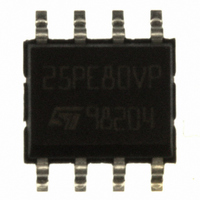M25PE80-VMN6TP NUMONYX, M25PE80-VMN6TP Datasheet - Page 13

M25PE80-VMN6TP
Manufacturer Part Number
M25PE80-VMN6TP
Description
IC FLASH 8MBIT 75MHZ 8SOIC
Manufacturer
NUMONYX
Series
Forté™r
Datasheet
1.M25PE80-VMN6TP.pdf
(66 pages)
Specifications of M25PE80-VMN6TP
Format - Memory
FLASH
Memory Type
FLASH
Memory Size
8M (1M x 8)
Speed
75MHz
Interface
SPI, 3-Wire Serial
Voltage - Supply
2.7 V ~ 3.6 V
Operating Temperature
-40°C ~ 85°C
Package / Case
8-SOIC (3.9mm Width)
Package
8SOIC N
Cell Type
NOR
Density
8 Mb
Architecture
Sectored
Block Organization
Symmetrical
Typical Operating Supply Voltage
3.3 V
Sector Size
256Byte x 4096
Timing Type
Synchronous
Interface Type
Serial-SPI
Lead Free Status / RoHS Status
Lead free / RoHS Compliant
Other names
M25PE80-VMN6TPTR
Available stocks
Company
Part Number
Manufacturer
Quantity
Price
Company:
Part Number:
M25PE80-VMN6TP
Manufacturer:
ST
Quantity:
6 000
Part Number:
M25PE80-VMN6TP
Manufacturer:
ST
Quantity:
20 000
M25PE80
4.3
4.4
4.5
4.6
A fast way to modify data
The page program (PP) instruction provides a fast way of modifying data (up to 256
contiguous bytes at a time), provided that it only involves resetting bits to 0 that had
previously been set to 1.
This might be:
For optimized timings, it is recommended to use the page program (PP) instruction to
program all consecutive targeted bytes in a single sequence versus using several page
program (PP) sequences with each containing only a few bytes (see
program
operation, T9HX (0.11 µm)
Polling during a write, program or erase cycle
A further improvement in the write, program or erase time can be achieved by not waiting for
the worst case delay (t
provided in the status register so that the application program can monitor its value, polling it
to establish when the previous cycle is complete.
Reset
An internal power-on reset circuit helps protect against inadvertent data writes. Addition
protection is provided by driving Reset (Reset) Low during the power-on process, and only
driving it High when V
Active power, standby power and deep power-down modes
When Chip Select (S) is Low, the device is selected, and in the active power mode.
When Chip Select (S) is High, the device is deselected, but could remain in the active power
mode until all internal cycles have completed (program, erase, write). The device then goes
in to the standby power mode. The device consumption drops to I
The deep power-down mode is entered when the specific instruction (the deep power-down
(DP) instruction) is executed. The device consumption drops further to I
mode, only the release from deep power-down instruction is accepted. All other instructions
are ignored. The device remains in the deep power-down mode until the release from deep
power-down instruction is executed. This can be used as an extra software protection
mechanism, when the device is not in active use, to protect the device from inadvertent
write, program or erase instructions.
when the designer is programming the device for the first time
when the designer knows that the page has already been erased by an earlier page
erase (PE), subsector erase (SSE), sector erase (SE) or bulk erase (BE) instruction.
This is useful, for example, when storing a fast stream of data, having first performed
the erase cycle when time was available
when the designer knows that the only changes involve resetting bits to ‘0’ that are still
set to ‘1’. When this method is possible, it has the additional advantage of minimizing
the number of unnecessary erase operations, and the extra stress incurred by each
page
(PP),
Table 22: AC
CC
PW
has reached the correct voltage level, V
, t
PP
process)).
characteristics, and
, t
PE
, t
SSE
, t
SE
or t
BE
Table 24: AC characteristics (75 MHz
). The write in progress (WIP) bit is
CC
CC1
(min).
Section 6.10: Page
.
Operating features
CC2
. When in this
13/66














